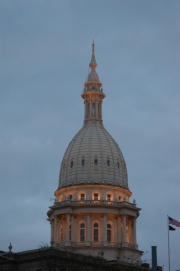 By Amanda Peterka
By Amanda Peterka
Great Lakes Echo
LANSING – The lights usually dim at 6 p.m. in Michigan’s Capitol. The schedule is meant to reduce energy use in Lansing’s historic centerpiece.
But when lawmakers are trying to pinch the state’s pennies late into the night during budget crises, lights glow long into the night, wasting energy and the very dollars that the Legislature is trying to save.
“The last budget crunch — for a week straight — the lighting wasn’t reduced at all until 1 a.m.,” said Steve Benkovsky, the Capitol’s operations manager who oversees the building’s energy use.
Spotlights and incandescent bulbs keep the chambers glowing warmly through the night – to mimic the Capitol’s original gas-lit rooms.
But maintaining appearances is costly. In 1879, when the Capitol was built, the state paid electricity bills for only a handful of newly invented light bulbs. Michigan now pays up to $30,000 a month in electric bills for lights to replicate that authentic image.
In her State of the State address, Gov. Jennifer Granholm said, “Our state government has cut electricity use by 23 percent and saved taxpayers some $60 million over the past three years.”
But Michigan’s need to preserve the Capitol as a historical symbol makes it a “unique animal” that can’t follow the same energy regulations that the governor ordered for other state buildings, Benkovsky said.
“This challenge is one we share with all historic buildings, and even a lot of museums,” said Kerry Chartkoff, the former director of the Capitol Tour and Information Service.
The chief task is to find the character-defining elements of the building, and then find technology that can be “incorporated into the building without having to destroy what makes that building very special,” said Gene Hopkins, its preservation architect.
And for the 129-year-old structure, it’s the mood created when hanging incandescent bulbs faintly illuminate the nine acres of interior walls decorated with gold leaf.
Chartkoff said, “The decorative paint is a hallmark. It’s very specific and beautiful, and lighting affects the way colors look in this building.
“Compact fluorescent lights change color balance, and not for the better,” she added, referring to the spiral-like lights that use less energy.
Rep. Mark Meadows, D-East Lansing, said that “when people come in and look at the Capitol and see it looking essentially the same” as it did in 1879, “I think they feel a sense of history of Michigan connected to the building a way that it’s hard for any of us to articulate.”
Although there’ s a delicate balance between energy and history, not everything in the Capitol is energy-wasteful.
Many changes were made during a major 1989-1992 restoration that won a national preservation award and made the building more flexible for new technology.
For example, the ground floor and loading dock, where no tourists are allowed, have more efficient lighting, and older windows everywhere were replaced with more efficient ones.
Its lighting schedule has also been adapted.
Because lawmakers and visitors are in the building and police never stop patrolling its corridors, lights always remain on. However, at 6 p.m., lighting is cut by 20 percent. By 1 a.m., it’s cut by 70 percent by dimming individual lights and shutting off others.
Of course, that all depends on how late legislators are present.
“Mondays and Fridays are easy, but Tuesday through Thursday is hard because they’re in session,” said Benkovsky, the operations manager. “If they’re going to be late, we put the lights down to 80 percent, but not more until they’re completely out.”
This doesn’t account for lights kept on inside the House and Senate chambers for extended sessions, including high-wattage lighting for the many cameras taping the deliberations. That requires more energy and heats up the rooms pretty quickly.
But because of its solid masonry walls and lack of large glassy areas exposed to the sun, the Capitol tends to cool itself naturally.
Chartkoff said, “In many ways it has its own climate. It keeps its humidity and comfort level more than modern buildings, with such a thick skin.”
Another development that took time was getting the public to come to terms with reduced lighting on the dome’s exterior. Two years ago, dome lighting was cut in half. People complained at first, but Benkovsky said he rarely hears any comments now.
Dome lights are further dimmed at midnight, along with lights facing the statue of Civil War Gov. Austin Blair on the front lawn. But four 500-watters still shine up, illuminating the building.
To Chartkoff, dimming the dome isn’t about energy savings.
“It’s a symbolic thing to show that we understand and are conserving everything that we can,” she said. “Dimming the lights on the dome at night doesn’t save us hardly anything.”
Meadows said it’s worth keeping the dome lit.
“I know it’s an expense, and we may get to the point where we have to pinch pennies so badly that we’re back to oil lamps on the desks,” Meadows said. “But it’s a symbol that no matter how tough the times are, as a people we still have this symbol of our statewide community.”